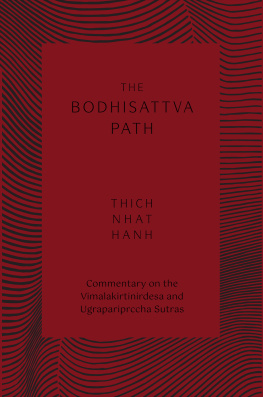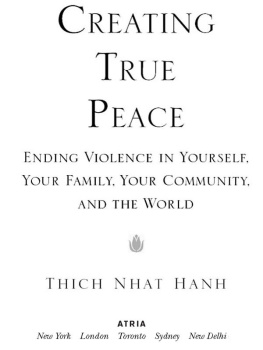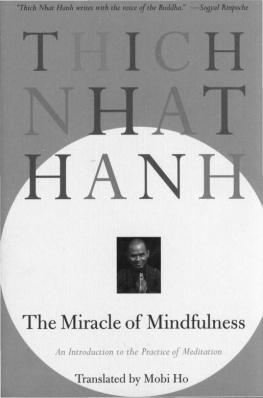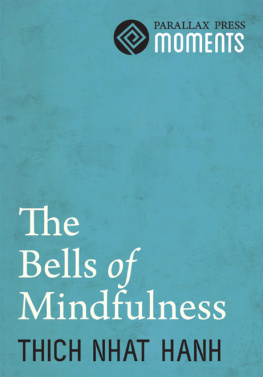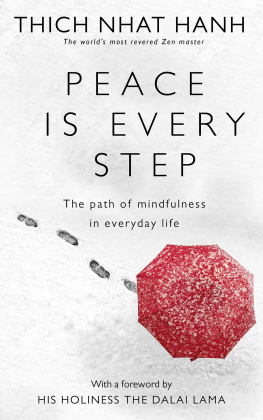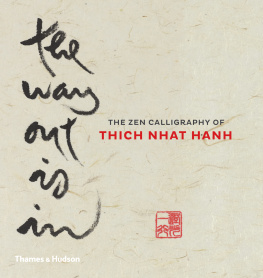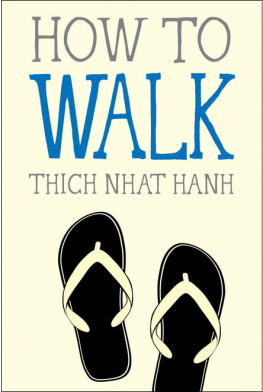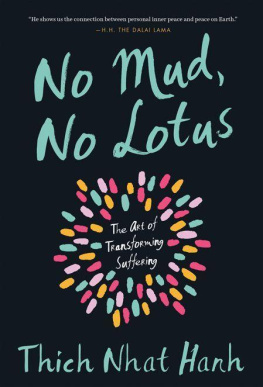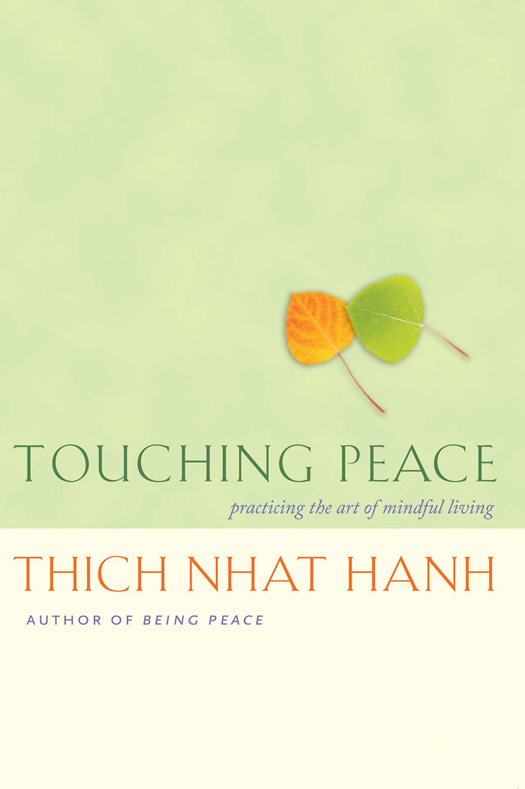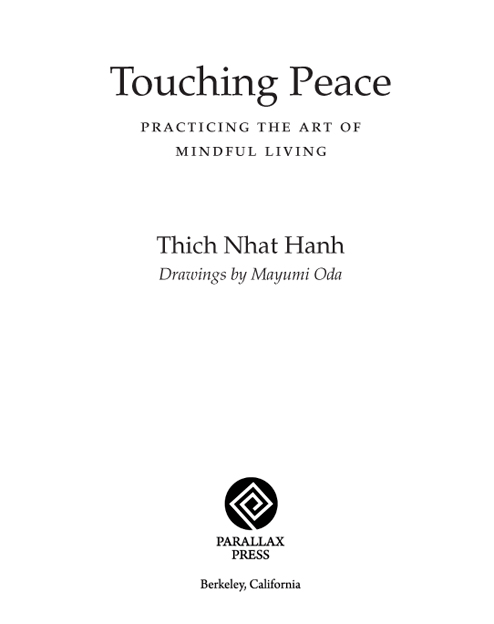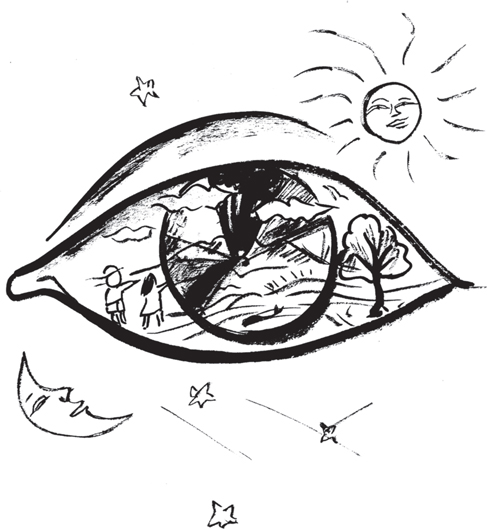Parallax Press
P.O. Box 7355
Berkeley, California 94707
www.parallax.org
Parallax Press is the publishing division of Unified Buddhist Church, Inc.
Original Edition 1992 by Unified Buddhist Church
Revised Edition 2009 by Unified Buddhist Church
All rights reserved.
Original editing by Arnold Kotler.
Thanks to Carol Melkonian, Shonen Bressler, and Alessandra Cornero for transcribing the tapes; to Brother David Steindl-Rast, Therese Fitzgerald, Stephen Batchelor, and Mushim Ikeda for helpful insights and suggestions; and to Edward M. Hayes for the idea of Todays Day from his book Twelve and One-Half Keys (Forest of Peace Books, Easton, KS 66020).
Cover and text design by Gopa&Ted2, Inc
Library of Congress Cataloging-in-Publication Data
Nht Hanh, Thch.
Touching peace : practicing the art of mindful living /
Thich Nhat Hanh ; drawings by Mayumi Oda.
p. cm.
Originally published: Berkeley, Calif. : Parallax Press, c1992.
ISBN 978-1-888375-99-2
1. Religious lifeBuddhism. I. Oda, Mayumi, 1941- II. Title.
BQ5410.N465 2009
294.3444dc22
2009025886
Ebook ISBN: 978-1-935209-04-1
v3.1
Contents
CHAPTER ONE
Life Is a Miracle
W HEN I WAS a young monk in Vietnam, each village temple had a big bell, like those in Christian churches in Europe and the U.S. Whenever the bell was invited to sound, all the villagers would stop what they were doing and pause for a few moments to breathe in and out in mindfulness. At Plum Village, the community where I live in France, we do the same. Every time we hear the bell, we go back to ourselves and enjoy our breathing. When we breathe in, we say, silently, Listen, listen, and when we breathe out, we say, This wonderful sound brings me back to my true home.
Our true home is in the present moment. To live in the present moment is a miracle. The miracle is not to walk on water. The miracle is to walk on the green Earth in the present moment, to appreciate the peace and beauty that are available now. Peace is all around usin the world and in natureand within usin our bodies and our spirits. Once we learn to touch this peace, we will be healed and transformed. It is not a matter of faith; it is a matter of practice. We need only to find ways to bring our body and mind back to the present moment so we can touch what is refreshing, healing, and wondrous.
Some years ago, I rode in a taxi in New York City, and I saw that the driver was not at all happy. He was not in the present moment. There was no peace or joy in him, no capacity of being alive while doing the work of driving, and he expressed it in the way he drove. Many of us do the same. We rush about, but we are not at one with what we are doing; we are not at peace. Our body is here, but our mind is somewhere elsein the past or the future, possessed by anger, frustration, hopes, or dreams. We are not really alive; we are like ghosts. If our beautiful child were to come up to us and offer us a smile, we would miss him completely, and he would miss us. What a pity!
In The Stranger, Albert Camus described a man who was going to be executed in a few days. Sitting alone in his cell, he noticed a small patch of blue sky through the skylight, and suddenly he felt deeply in touch with life, deeply in the present moment. He vowed to live his remaining days in mindfulness, in full appreciation of each moment, and he did so for several days. Then, just three hours before the time of his execution, a priest came into the cell to receive a confession and administer the last rites. But the man wanted only to be alone. He tried many ways to get the priest to leave, and when he finally succeeded, he said to himself that the priest lived like a dead man. II vit comme un mort. He saw that the one who was trying to save him was less alive than he, the one who was about to be executed.
Many of us, although alive, are not really alive because we are not able to touch life in the present moment. As Camus says, we are like dead people. I would like to share with you a few simple exercises we can practice that can help us reunify our body and mind and get back in touch with life in the present moment. The first is called conscious breathing; human beings like us have been practicing this for more than three thousand years. As we breathe in, we know we are breathing in, and as we breathe out, we know we are breathing out. As we do this, we observe many elements of happiness inside us and around us. We can really enjoy touching our breathing and our being alive.
Life is found only in the present moment. I think we should have a holiday to celebrate this fact. We have holidays for so many important occasionsChristmas, the New Year, Mothers Day, Fathers Day, even Earth Day. Why not celebrate a day when we can live happily in the present moment all day long? I would like to declare today Todays Day, a day dedicated to touching the earth, touching the sky, touching the trees, and touching the peace that is available in the present moment.
Over twenty years ago, I planted three beautiful Himalayan cedars outside my hermitage, and now, whenever I walk by one of them, I bow, touch its bark with my cheek, and hug it. As I breathe in and out mindfully, I look up at its branches and beautiful leaves. I receive a lot of peace and sustenance from hugging trees. Touching a tree gives both you and the tree great pleasure. Trees are beautiful, refreshing, and solid. When you want to hug a tree, it will never refuse. You can rely on trees. I have even taught my students the practice of tree-hugging.
At Plum Village, we have a beautiful linden tree that provides shade and joy to hundreds of people every summer. Once, during a big storm, many of its branches were broken off and the tree almost died. When I saw the linden tree after the storm, I wanted to cry. I felt the need to touch it, but I did not get much pleasure from that touching. I saw that the tree was suffering, and so I resolved to find ways to help it. Fortunately, our friend Scott Mayer is a tree doctor. He took such good care of the linden tree that now it is even stronger and more beautiful than before. Plum Village would not be the same without that tree. Whenever I can, I touch its bark and feel it deeply.
In the same way that we touch trees, we can touch ourselves and others with compassion. Sometimes, when we try to hammer a nail into a piece of wood, we pound our finger instead of pounding the nail. Right away we put down the hammer and take care of our wounded finger. We do everything possible to help it, giving first aid and also compassion and concern. We may need a doctor or nurse to help, but we also need compassion and joy for the wound to heal quickly. Whenever we have some pain, it is wonderful to touch it with compassion. Even if the pain is insidein our liver, our heart, or our lungswe can touch it with mindfulness.
Our right hand has touched our left hand many times, but it may not have done so with compassion. Let us practice together. Breathing in and out three times, touch your left hand with your right hand and, at the same time, with your compassion. Do you notice that while your left hand is receiving comfort and love, your right hand is also receiving comfort and love? This practice is for both parties, not just one. When we see someone suffering, if we touch her with compassion, she will receive our comfort and love, and we will also receive comfort and love. We can do the same when we ourselves are suffering. Touching in this way, everyone benefits.


